This story comes from our partner ![]() .
.
Spending on health care has, of course, been rising in the U.S. for decades. Health care now accounts for 18 cents of every dollar Americans spend, up from 7 cents in 1970.
But where, exactly, is all that money going? And, for that matter, where is the money coming from to pay for all that health care? We found answers to both of these questions in this data set.
First, here’s where the money is going.

Source: Centers for Medicare and Medicaid Services. Illustration by Lam Thuy Vo/NPR
Despite huge changes in medicine and medical technology, the share of health dollars that flows to each major category has changed little in the past 40 years. In other words, spending on each category — drugs, hospitals, doctors, etc. — has increased at about the same rate.
What has changed dramatically is where the money comes from.

Source: Centers for Medicare and Medicaid Services. Illustration by Lam Thuy Vo/NPR
In 1970, by far the biggest share of health care spending was what people spent out of their own pockets. Today, insurance (private plans along with Medicare and Medicaid, which are government-run) covers almost everything.
We emailed Uwe Reinhardt, the Princeton health economist, to ask about this shift.
Insurance coverage has become much more comprehensive, he said.
For example, in 1970, people typically had to pay for drugs out of their own pockets. By 2000, it had become routine for private insurance to cover drugs. Medicare drug coverage began in 2006.
What’s more, he said, in many cases, employees gave up some freedom of choice in health care in exchange for less out of pocket spending. But that trend is reversing itself, he said.
“Now we are going the other way, with higher deductibles and coinsurance for employer-based plans,” he said.
A giant, long-term study conducted in the ’70s and ’80s is relevant here. Researchers randomly assigned people to receive different types of insurance — some had full coverage, while others had to pay for a big chunk of the care they received.
People had to pay more for care tended to get less care. And people who were poor and who had to pay more for care fared worse on some key health measures.
The underlying question here is one of the oldest and most contentious in health economics: What costs should health insurance cover, and what costs should be left to individual patients?
For more, see NPR’s recent story on insurance coverage for breast pumps, and see the Kaiser Family Foundation’s Health Care Costs Primer. (KHN is an editorially independent program of the Kaiser Family Foundation.)






